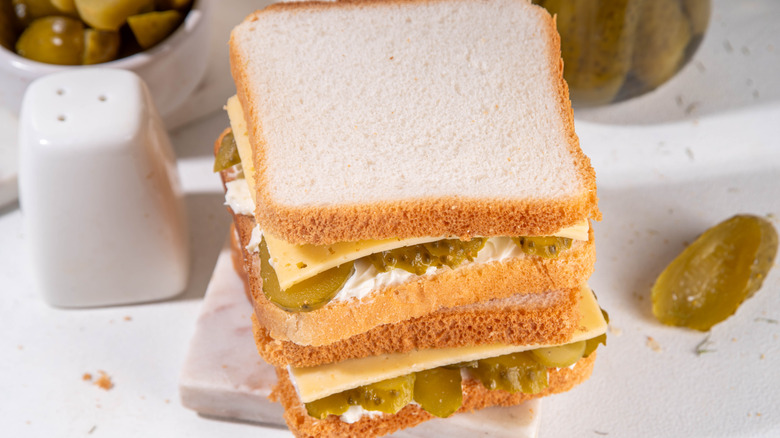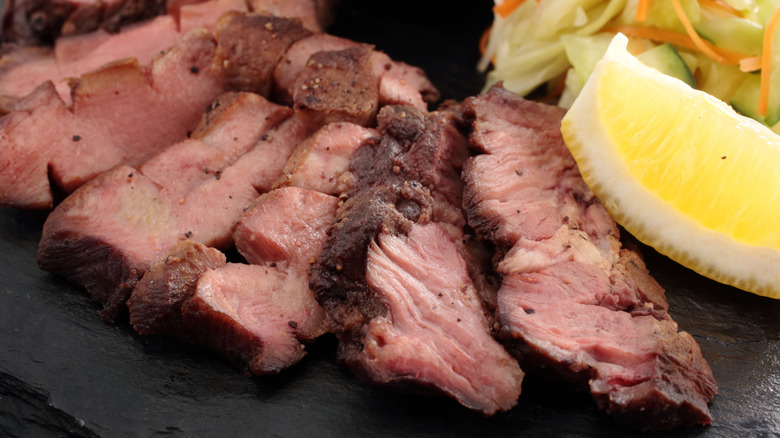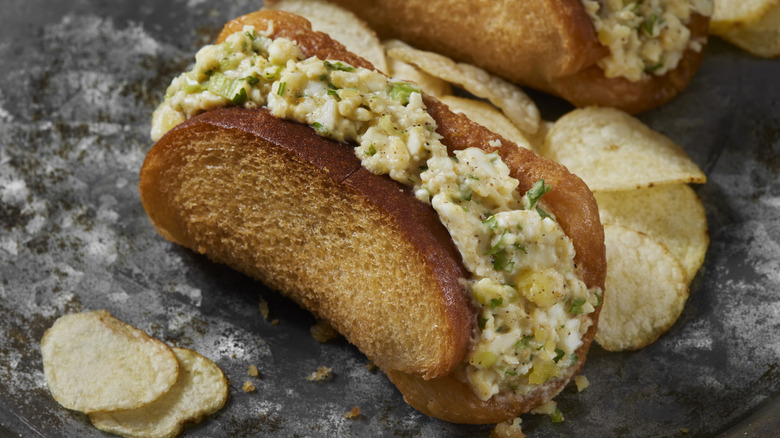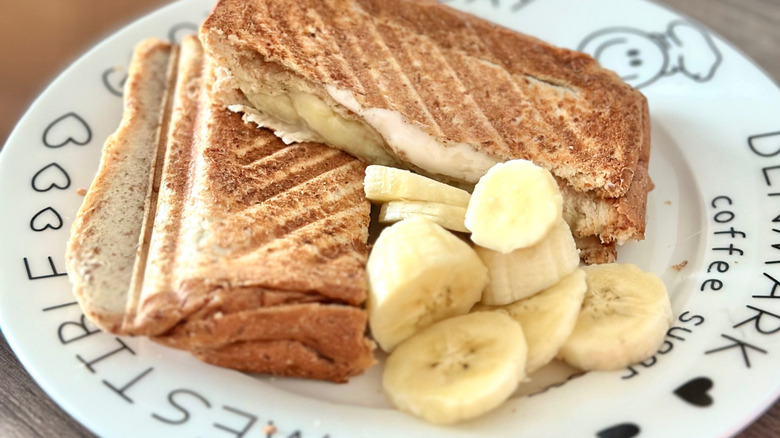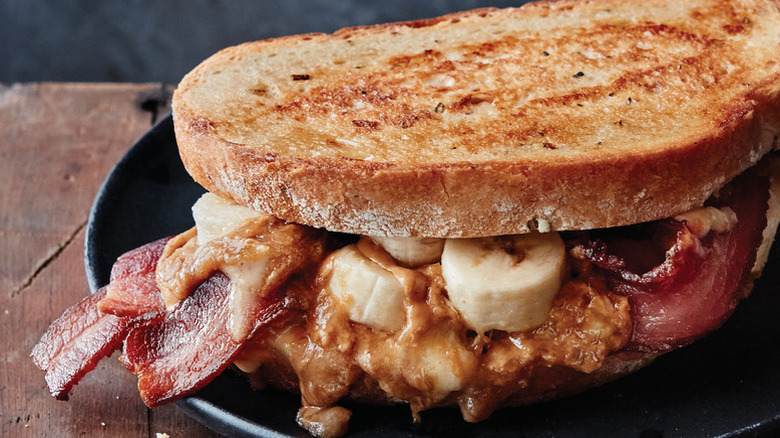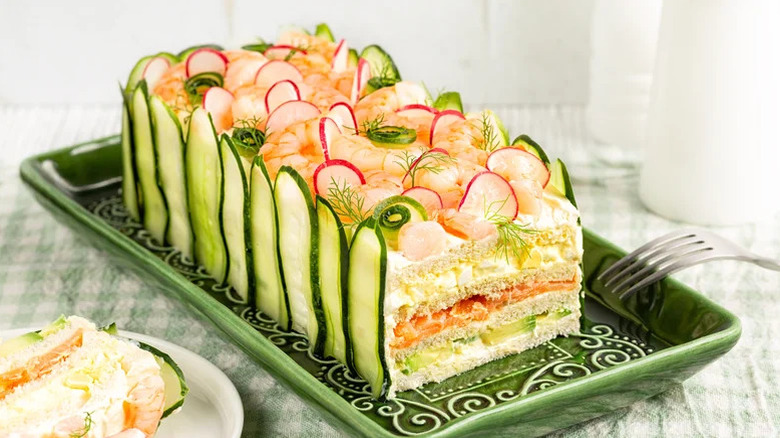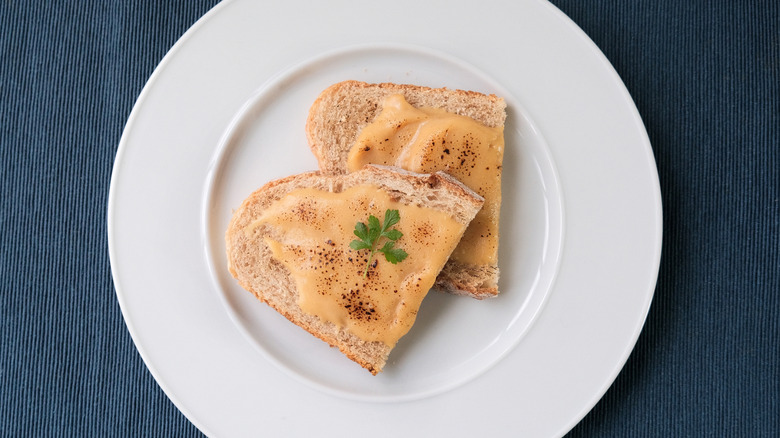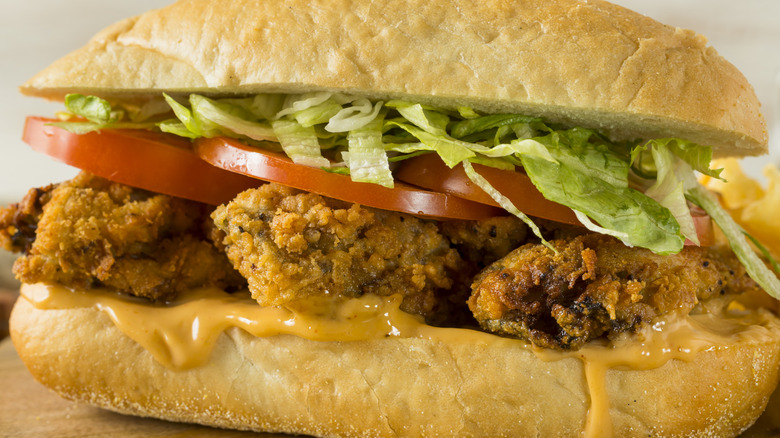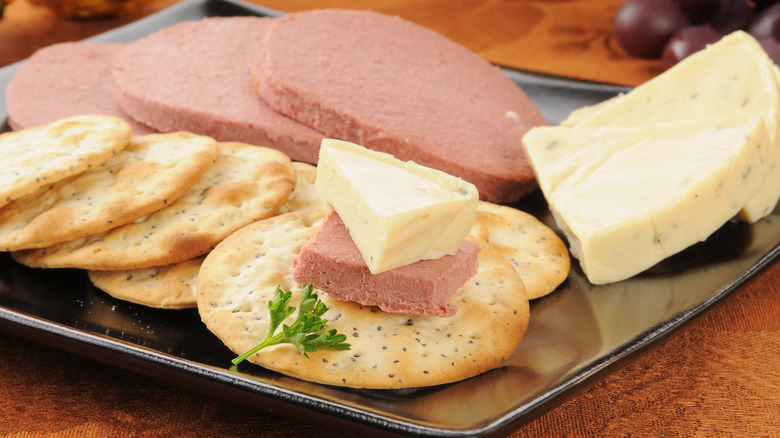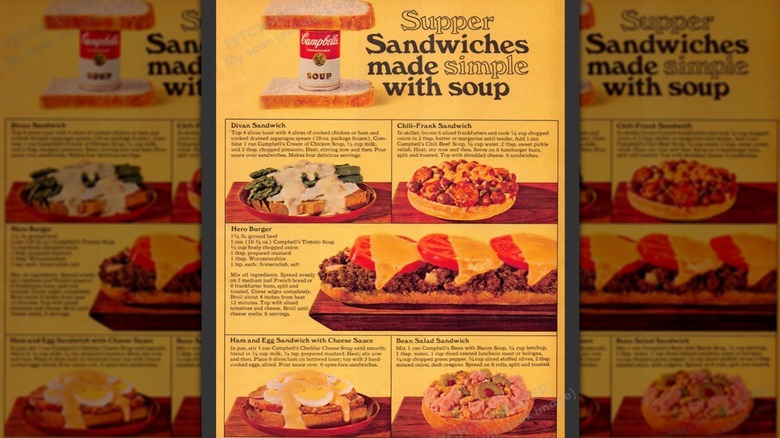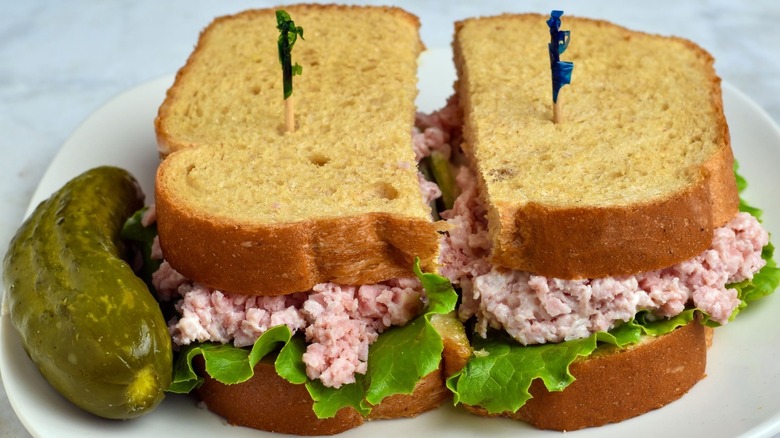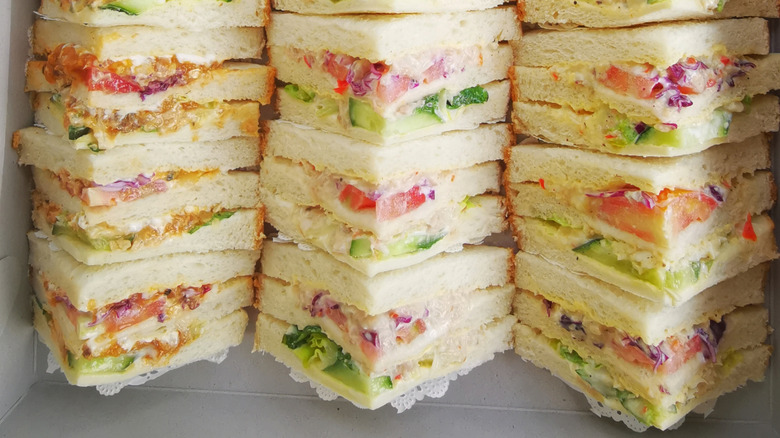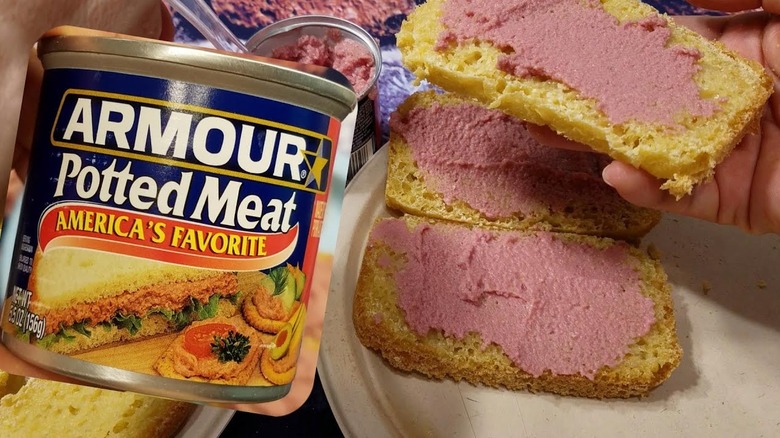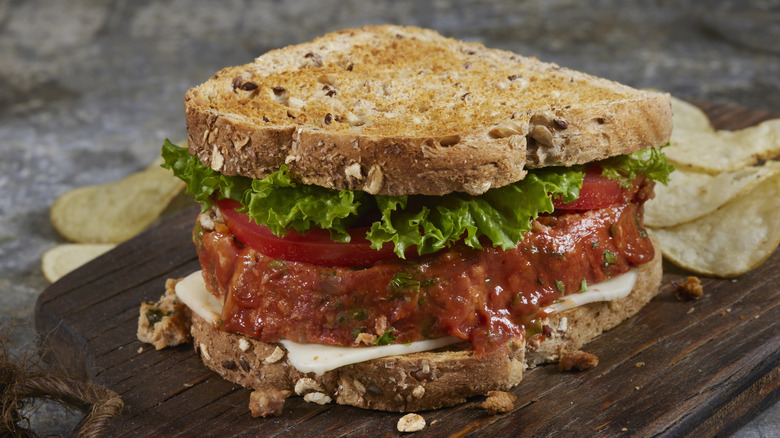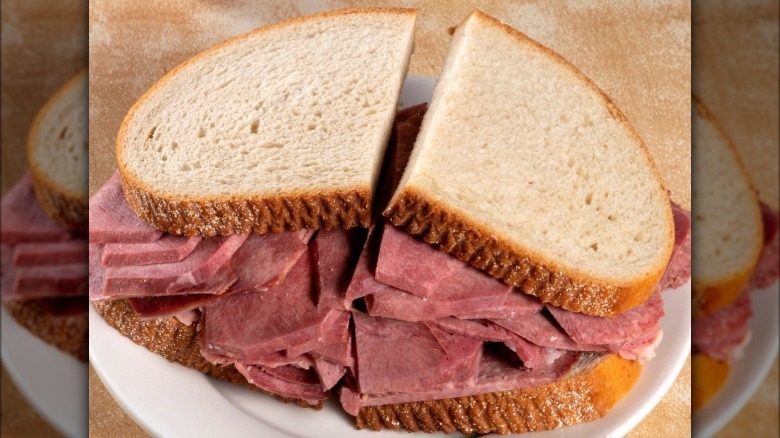16 Old-School Sandwiches Hardly Anyone Eats Anymore
We may receive a commission on purchases made from links.
The sandwich has been an American lunch staple for hundreds of years. Some of the most popular sandwiches during different decades were created out of culinary creativity, while some were born of necessity during financially difficult times. The Great Depression and World War II tested people's limits and resourcefulness as they tried to make every meal enjoyable when means were extremely limited. This led to many interesting flavor and texture combinations that we may not have come up with otherwise.
While some sandwiches created many years ago have stood the test of time, these poor lunches have gone by the wayside as other options were more favorable. When fresher food became more readily available, sandwich fillings like potted meat, mock ham salad, and oysters were left behind and taken off of menus forever. Although you may no longer be able to order them, these meals are a testament to culinary ingenuity and evoke nostalgia for a bygone era.
Beef jelly sandwich
In the 1920s, resourcefulness was a key in the American kitchen, and this translated to butchers and other food workers. To use as much of the animal as they could, butchers came up with ways to use the less savory parts of the animal that were not as widely used, and one of these ways was the beef jelly sandwich. While this would rarely be seen on plates today, as the necessity of cheaper cuts of meat is not as prevalent, it was a creative staple in the earlier decades of the 1900s.
To make this sandwich, one was instructed to cook beef heart, pig feet, and beef tongue together in a pot. The elements would become tender and cook down, at which point you would put the mixture in the icebox to cool until it became gelatinous. Then, it could be sliced up and used as the main component of a sandwich, paired with mustard, mayo, or pickles to add dimension. This provided a resourceful, while a bit unorthodox, way to use all parts of an animal for a lower cost.
Emergency sandwich
This one is aptly named the emergency sandwich because it includes ingredients you most likely already had on hand. Popular during the mid-1930s, food scarcity meant that lunch sometimes involved whatever you could stick between slices of bread. This recipe combines hard-boiled eggs and pickles mixed with mustard and peanut butter. Recipes note that if the mixture is too thick for your taste, it can be thinned out with vinegar. The result offered a hearty combination of proteins, healthy fats, and a bit of acidity to make it less bland than other options. While a good source of protein, one has to wonder at the flavor combination.
These ingredients were nutrient-dense and shelf-stable, so while this food might be a marvel to our modern taste buds, it was popular during a time when long-lasting sustenance was crucial. Grocery trips were often irregular, so people tended to stock up on things that would last a long time in the pantry or refrigerator, and of course, they were aiming for the cheapest options. This sandwich combines the best of both worlds, although it has since faded out of popularity.
Banana sandwich
Although it sounds overly basic to our modern tastes, this sandwich was a treat for Depression-era children who grew sick of peanut butter sandwiches every day. The banana sandwich is just what it sounds like: sliced or mashed banana on bread, usually dark or whole grain. This bread was the most filling, and the banana offered a sweet alternative to the salty lunch meats kids were used to. If you were really spoiled, your parents would add a bit of butter or a sprinkle of sugar to make it a true indulgence.
Produce was notoriously hard to get during the Great Depression, but bananas were usually an exception. They were comparatively inexpensive and widely accessible, with no cooking required. While bananas are now considered a breakfast staple, they were once a popular lunchtime treat that provided enough energy to last the school day. While you won't find this sandwich on many restaurant menus, some people who grew up with it will still enjoy it once in a while for nostalgia's sake.
Makeshift sandwiches
From the beginning of the Great Depression, food scarcity required Americans to be creative with what they already had on hand, as buying food swiftly became a luxury. It was out of necessity that "makeshift sandwiches" were created. This category covered anything that could be found in your pantry, from ketchup to butter to simple salt and pepper sandwiches. While these options seem unappetizing, they were more a matter of survival than taste. Bread was one of the cheaper grocery options, so people loaded it with whatever they could find to get their calories in.
These sandwiches were very far from anything gourmet, but some folks still enjoy the occasional butter sandwich to remember the childhood staples they grew up on. It was not an option to waste any food or be frivolous, so people were forced to test their resourcefulness. Because they are so plain, though, you'll never find a ketchup or salt and pepper sandwich on a menu.
Elvis sandwich
While Elvis Presley was of course known for his mark on rock 'n' roll history, he was also known for his indulgent diet – and his favorite sandwich became a culinary legend. The King's sandwich combined bananas, bacon, and peanut butter, and was then deep-fried. Elvis would devour two to four of these sandwiches regularly and order them at his favorite diners. While this monster is sometimes served in diners in cities where Elvis most commonly performed, it is not typically found at chain restaurants.
Elvis loved the sandwich for its extreme calorie count and combination of sweet and salty flavors. This lunch is great for more adventurous eaters to try out, and some places have taken inspiration from the flavors and used them for things like donuts and milkshakes. This Franken-food is a fun link to the celebrity whom many have adored through the decades and even made their own twists on.
Frosted sandwich loaf
If you've ever taken a deep dive into mid-century cookbooks or home living magazines, you may have stumbled across the frosted sandwich loaf. This monstrosity was once made at teatime for guests, but is now nowhere to be found in anyone's recipe book. While it looks like a cake from the outside, you won't find anything sweet in its center. Just like the name implies, layers of egg salad, pickles, chicken salad, and deviled ham are sandwiched into a giant loaf, and then frosted with a mixture of mayonnaise and cream cheese. This dish was elaborate and time-consuming to make, so the goal was to impress guests at tea time or luncheons.
This meal was once a mark of highly sophisticated dining, but it has since vanished from recipe books and blogs. The mix of fillings is overbearing, and the heavy mixture of mayonnaise and cream cheese or dressing makes for a heavy dish that many find too much for midday. Additionally, people no longer spend as much time preparing for teatime meals, and working people simply don't have the time to assemble this beast.
Welsh rarebit
While the name may lead you astray, the Welsh rarebit was a fairly simple sandwich consisting of a cheesy sauce poured over bread. The sauce was made with a cheese of your choice, beer, Worcestershire, and hot sauce or red pepper flakes, and was most often served as an open-faced sandwich over sourdough bread. It was a sizable, hearty meal, and due to its simple ingredients, it was fairly affordable through the '40s and '50s. The combination of cheese and bread is one that is streamlined all through American cuisine.
Popularized in the U.K., the Welsh rarebit made its way overseas and was a lunch counter staple through the seventies. However, once meat became more affordable, this sandwich fell to the wayside. This was an example of a popular comfort food that was made of simple and accessible ingredients, but was no longer as popular once heartier food items were more easily affordable.
Oyster club sandwich
Beginning in the early 1800s and spanning into the 1900s, oysters were less of a luxury item and more of a common street food. Starting in the '20s, oysters were actually a very common sandwich filling, one of the most popular options being the oyster club sandwich. The sandwich included fried oysters, lettuce and tomato, and a spicy horseradish sauce. The crispy seafood and flavorful sauce made for a simple meal that felt luxurious.
This iteration of a more well-known turkey club or BLT became less popular as oyster prices rose and they were no longer a common everyday food. Oysters became not only expensive but also difficult to obtain, so this sandwich faded from menus. While sometimes still served fried, oysters are most often served on their own now, and are more of a luxury item than they once were. You'll be hard-pressed to find this item on a menu, even in seafood restaurants.
Braunschweiger
Braunschweiger is a German sausage that is made of pork meat and liver. This was a hugely popular fixin' for sandwiches in the early 1900s, and was often spread on toast and coupled with mustard or pickles. This was a high-protein filling and was more affordable than other lunch meats, so it was a reliable staple in the lunchboxes of students and people in the workforce alike. Today, you can find many variations of German sausage, but in the early part of the century, this was the most widely available.
Braunschweiger started to fall out of popularity once people started eating more fresh meat. Braunschweiger was preserved, and while this had the appeal of a longer shelf life, the flavor was no match for fresh products. Greater access to refrigeration meant people could have their first choice of meat, and they usually went with the fresh option over the canned or preserved. Younger generations also preferred turkey and ham to the strong flavor of the sausage, so this lunchmeat is difficult to find now. You'll be able to find it in some German groceries and specialty stores, but it is nowhere as mainstream as it was.
Peanut butter and mayonnaise sandwich
Another product of the Great Depression, the peanut butter and mayonnaise combination was very clearly a result of scarcity. Jam and fruit spreads were expensive, so people were reaching for whatever they could make last the longest in their pantry. Peanut butter was high-protein and flavorful, while mayonnaise was creamy and calorie-dense. While the combination may not have been the first choice of families in this era, it was nutritious, and that took priority over flavor.
It's no mystery why people have let this sandwich fizzle out. The flavors together are strange, and the texture is unappealing. Surprisingly, this one stuck around into the sixties, not immediately disappearing when the trouble of the Depression started to fade. Mayonnaise was very popular with American palates, and peanut butter remains a favorite to this day. The main reason this once fell off the radar was that other ingredients became much more affordable, and so more pleasant flavor combinations were available. Though some people nowadays love a banana and mayo sandwich.
Broiled soup sandwiches
In the 1960s, Campbell's Soup was sweeping the nation as an easy, affordable meal option. With soups and stews stocking the nation's pantries, home and restaurant cooks alike started using them as sandwich fillings. However, the result was sloppy, soggy, and left much to be desired in terms of looks. Some recipes used thick soups like cream of chicken, while some used beef stew as the filling, but all iterations of this sandwich seemed to have something missing, resulting in it quickly fading out of popularity.
Campbell's even began posting recipes in magazines and newspapers, advertising different soups to try in open-faced sandwiches. It was time to not only enjoy soup with your sandwich, but put them both together and stick the whole thing in the oven to broil. The whole thing was reminiscent of a military meal, and not something people wanted to enjoy regularly after a point. Though one soup and sandwich combo from the 1920s did stick around in the form of grilled cheese and tomato soup. Just, you know, separately.
Mock ham salad sandwich
The mock ham salad sandwich became popular when folks might have everything in their pantry to make a ham sandwich, except, due to costs, the ham. Instead of the real thing, people combined chopped bologna or Spam with mustard, mayo, and relish to replicate the taste and texture that ham salad was known for. This actually tasted and appeared very similar to the real thing, and it helped people feel like they were enjoying one of their comfort foods on a budget.
Now, it's difficult to find ham salad on any menu, mock or otherwise. Although ham did eventually become more available even for budget-conscious consumers, the dish was not as regularly served as plain ham on sandwiches. This dish alluded to lean times for many, so people were ready to abandon the recipe for different, fresher, and more flavorful choices once they had the means.
Egg and sardine sandwich
In the 1920s and '30s, protein sources were hard to come by. You could not just go to your local deli to grab some cold cuts, as prices were extremely high and meat was scarce. Eggs and sardines became a solution for many. Both items were high in protein and easy to prepare, and they could easily be found at any corner or grocery store. These ingredients, while perhaps not the most appetizing, were nutrient-dense and extremely filling, giving consumers healthy omega-3 fatty acids.
The flavors, as aforementioned, were harsh, and there was little to be done to mask the strange combination. As time went on, as with many of the sandwiches listed here, tastier options became attainable once again, and people stopped reaching for sardines and eggs, at least together. This relic is another Depression-era meal that was sourced from necessity during trying times.
Potted meat sandwich
Potted or canned meats were extremely popular in the early 20th century because the meat was preserved for much longer than traditionally packaged meat. Beef or chicken were the most common canned meats, preserved with oil and a heavy dose of salt. For working families and families with children in school, smearing some potted meat on two slices of bread was as simple as it got. People could stock up on these meats and then keep them for several months without worrying about spoilage. This meal was quick, simple, and would stretch grocery money.
However, when refrigeration started to get more popular, people did not have as much need for meat that would last longer, especially when fresh deli items tasted so much better. As it became commonplace for families to have fully functioning refrigerators in their homes, they didn't need to stock up on shelf-stable goods and could buy fresher ingredients. Potted meat quickly became old-fashioned and fell out of style for the everyday consumer. Potted meat also tasted extremely processed and was not as flavorful as, say, canned tuna or sardines.
Cold meatloaf sandwich
Meatloaf was one of the cheapest dinner staples available during and shortly after the Great Depression. This was a comfort food during a time when people could rarely afford comfort foods, so it was a weekly option for many families. You could make your ground beef stretch a bit further by supplementing it with breadcrumbs or vegetables that could feed your whole family with leftovers. This is where the cold meatloaf sandwich came in. You could simply put a slice between bread, add some ketchup or seasonings, and have a hearty lunch for the whole family.
This sandwich stuck around for decades and is still served in some American homes. However, it used to be so popular that you could walk into any diner or lunch counter and order a cold meatloaf sandwich on your choice of bread and no one would think twice about it. It's a good thing that popular opinions state the best meatloaf sandwiches are homemade in the kitchen.
Beef tongue sandwich
Many modern folks will recoil when reading about eating beef tongue, but this was a staple for many Americans in the early 19th century. Tongue was an exceptionally cheap cut of meat, so people got creative in terms of coming up with new ways to cook it. Cooks could broil it, bake it, or serve it corned, and slice it up to put on sandwiches with horseradish and pickles.
This meal was definitely popular, but one has to assume it was more out of necessity than flavor. Tongue was cheap and easy to get, and people did not have the option of oven-roasted turkey or ham yet. Beef prices eventually dropped, and other cuts of the animal became less pricey, so people were once again able to select the cuts of meat they actually wanted to eat, not just what they could afford. Remarkably, there are still some modern recipes that are used in delis to doctor up beef tongue for the perfect sandwich, but it is nowhere near as popular (though you can still get it at Katz Deli, one of Anthony Bourdain's favorites).

